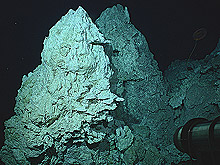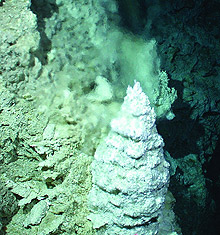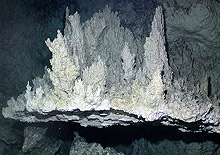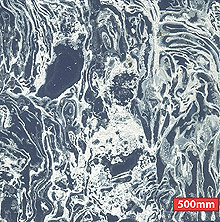
This is one of the four pinnacles that form the "crown" on the top of the Poseidon tower. This pinnacle is several meters across and is actively venting. Click image for larger view and image credit. (HR)
Formation of Carbonate Chimneys at the Lost City Hydrothermal Field
Kristin Ludwig
Graduate student
University of Washington
Deborah S. Kelley
Associate Professor
University of Washington
White Giants
The spectacular chimneys at Lost City are the largest known hydrothermal vent structures in the ocean and grow 20-60 m (~65-200 feet) above the seafloor. The chimneys are composed of mainly limestone (calcium carbonate), the same type of rock found in caves or in hot springs such as Yellowstone National Park. Lost City chimneys have a very simple mineralogy and are dominated by a mixture of three minerals: aragonite, calcite (both polymorphs of calcium carbonate, CaCO3), and brucite (Mg(OH)2). All three of these minerals are typically white in color, giving the chimneys at Lost City the ghostly white appearance that stands out so well in the deep sea.

This "beehive" deposit has formed on the side of another structure. It emits pH ~10 fluids that are ~90?C. These fluids are nearly particulate-free and can be seen shimmering above the top of the beehive cone. Click image for larger view and image credit. (HR)
Flanges, Beehives, Fingers, and Towers
Not all of the structures at hydrothermal vent fields are large chimneys or towers. While these are the most common formations at both Lost City and black smoker sites, hydrothermal vents come in all shapes and sizes. This is mostly due to the nature of fluid flow through the chimneys. The most prominent feature at Lost City is the Poseidon complex. Aptly named after the mythological god of the sea, the main tower at Poseidon rises 60 m (nearly 200 feet) above the seafloor and has a "crown" of four individual chimneys (fig. 1) connected by carbonate saddles. Poseidon is flanked by large buttresses of smaller pinnacles and drapery formations that are reminiscent of cave deposits. On the sides of Poseidon and other chimneys are beautiful examples of different structures, such as "beehive" (fig.2) formations and fragile flanges. Like an upside down bowl, flanges trap warm fluids that form a reflective pool that is typically an excellent site for fluid sampling. The buoyant fluids flow over the lip of the flange and sometimes through the roof of the flange, creating small, spindly chimneys on top of the flange (fig. 3). In other parts of the field are delicate carbonate chimneys that are just beginning to form. Some of these young deposits look like up-turned hands and fingers or seams in the wall rock, outlined in white carbonate. Talus of carbonate rubble and old splintered chimneys surround the base of most of the large structures in the field.

This flange has fluids both trapped underneath and flowing through the top of it to form the smaller chimneys on the top. It is about 1 m across. Click image for larger view and image credit. (HR)
Chimney Geology on a Small Scale
When chimney samples from Lost City are cut in half, their cross section looks much like a kitchen sponge. In most Lost City chimneys, there appears to be no "pipe" through which the vent fluids flow, but instead there are loosely connected open spaces (pore spaces) through which fluids gently percolate upwards and outwards.
To better understand the formation and development of the Lost City chimneys, samples of vent structures are cut into small pieces and then ground to a thickness thinner than a sheet of paper (fig.4). These "thin sections" are mounted on glass slides and are examined using a petrographic microscope. Thin sections provide an additional means of analyzing the mineralogy, porosity, and petrographic textures of individual rock samples. Thin sections of young chimneys indicate that these vents are very porous (fig. 4) and are filled with pockets of warm vent fluid that diffusely moves through the structures. These pore spaces are likely ideal habitats for microorganisms that thrive on and within the chimney walls.

In a paper-thin section of a chimney from Lost City, a network of pore spaces (dark areas) define meandering fluid flow paths through walls of aragonite, brucite, and calcite. The wispy nature of the carbonate deposition may reflect nucleation of carbonate on bacterial that form long strands or filaments on the outside of actively venting chimneys. Click image for larger view and image credit.
Precipitation of Calcium Carbonate on the Seafloor
The hydrothermal fluid emitted from the chimneys at Lost City has a very high pH (9-11) and carries up to three times the amount of calcium as seawater. When calcium-rich fluid with high pH mixes with relatively acidic seawater (pH ~8), the calcium in the fluids combines with carbonate and bicarbonate from seawater to precipitate aragonite and calcite (CaCO3). This is known as a "buffer reaction" and is very common in marine systems. The mineral brucite (Mg(OH)2) precipitates from the mixing of hydroxide-rich fluids with magnesium from seawater. These mineral deposits continuously build on one another to form the Lost City chimneys. Both aragonite and brucite are only stable at warmer temperatures, so actively venting chimneys that are bathed in warm vent fluid contain all three of these minerals, while inactive older structures are dominated by calcite.
In the oceans, calcium carbonate dissolves below a certain depth, known as the "calcium carbonate compensation depth" or CCD. In the Atlantic, the CCD is at ~4000 m, well below the depth of Lost City, so that the chimneys are preserved.
How old is Lost City?
Although Lost City was just discovered in 2000, it has been venting for at least 30,000 years. Scientists have used radiocarbon dating to determine the age of some of the carbonate chimneys at Lost City. Some of the actively venting samples are very young and are only 0 (modern) to ~500 years old. Other samples range in age from hundreds of years to more than 25,000 years old. Although 30,000 years seems like a long time, the vent field is relatively young compared to the 1.5 million year old ocean crust on which it has formed.
Understanding the chemistry, formation, and evolution of the Lost City chimneys contributes to piecing together the puzzle of the geologic history of this unique site and ultimately may help determine how Lost City began and what types of features explorers should look for in the future when searching for new vent sites similar to Lost City.


























